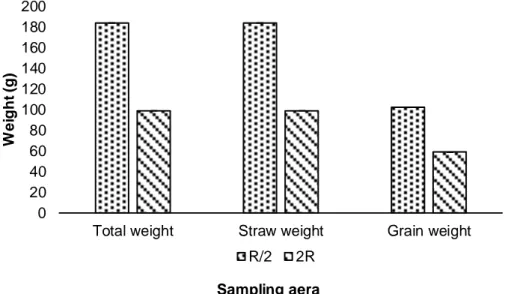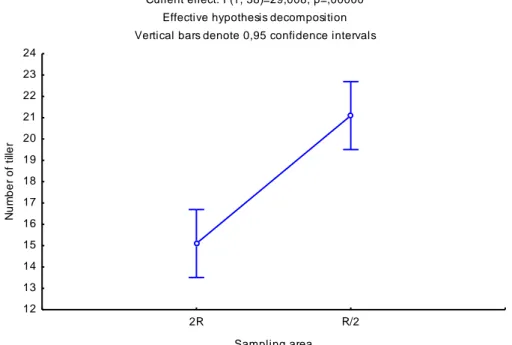HAL Id: hal-02743543
https://hal.inrae.fr/hal-02743543
Submitted on 3 Jun 2020
HAL is a multi-disciplinary open access
archive for the deposit and dissemination of sci-entific research documents, whether they are pub-lished or not. The documents may come from teaching and research institutions in France or abroad, or from public or private research centers.
L’archive ouverte pluridisciplinaire HAL, est destinée au dépôt et à la diffusion de documents scientifiques de niveau recherche, publiés ou non, émanant des établissements d’enseignement et de recherche français ou étrangers, des laboratoires publics ou privés.
Boubacar Camara, D. Ngom, D. Sanogo, Marie Gosme, Christian Dupraz
To cite this version:
Boubacar Camara, D. Ngom, D. Sanogo, Marie Gosme, Christian Dupraz. Influence of faiherbia albida on upland rice productivity. 3. European Agroforestry Conference (EURAF 2016), May 2016, Montpellier, France. 466 p., 2016, Celebrating 20 years of Agroforestry research in Europe : Book of Abstracts. �hal-02743543�
INFLUENCE OF FAIHERBIA ALBIDA ON UPLAND RICE
PRODUCTIVITY
*CAMARA B1,2,3, NGOM D1, SANOGO D2,GOSME M3 et Christian DUPRAZ3 *Correspondence author: camarabouba2@gmail.com;b.camara3390@zig.univ.sn
(1) Laboratoire d’Agroforesterie et d’Écologie (LAFE) – Département d’Agroforesterie / UFR ST / Université Assane SECK de Ziguinchor / Sénégal BP: 523 (2) Institut Sénégalais de Recherches Agricoles, Centre National de Recherches Forestières, BP:2312, Dakar Hann, Sénégal (3) INRA, UMR SYSTEM (Systèmes de Culture Tropicaux et
Méditerranéens) Montpellier
Introduction
In semi-arid regions of West Africa, most farmers consider the trees as an integral part of the cropping system. They have maintained over the centuries the traditional system of land use, that of the "parkland" where trees are scattered in cultivated fields (Boffa, 2000, Dan Guimbo et al., 2010). The farmers of Casamance are no exception to this rule. In lower Casamance ,
Faidherbia albida (Del.) Chev. has always been associated with upland rice. The species is
characterized by its inverted phenological rhythm: it loses its leaves during the rainy season and remains leafy during the dry season, reducing light competition with the crop. Furthermore, this tree is able to fix nitrogen, improving soil fertility, and its taproot system reduces water competition with the crops. Therfore F. albida’s interest is very large in agroforestry (in combination with both agriculture and livestock) and many traditional systems rely on the beneficial effects of Faidherbia albida on microclimate, soil fertility and finally intercrop productivity. The general objective of this study is to contribute to the understanding of the influence of this type of park on the productivity of rainfed rice, testing the hypothesis "Faidherbia albida has a positive impact on the productivity of rainfed rice."
Material and methods
To test this hypothesis, rice yields were measured in eight 0.25 x 0.25m squares around each of 5 trees: four in the area under the influence of the tree (below the tree crown, at a distance R/2 from the tree trunk with R the radius of the crown) and four outside (at a distance of 2R), on the East, South, West and North side of the tree. Thus, a total of 40 squares were measured including 20 inside the area of influence of the tree. The following measurements were done in each square: total biomass weight, straw and grain weight, number of tillers with panicles and plant height (from crown to the base of the panicle, measured on 5 randomly chosen tillers). Analysis of variance (1-way ANOVA: effect of sample location inside vs outside of the tree influence) on theses variables was performed with the statistical software STATISTICA 7. Results and discussion
Results
Results of the ANOVA show significant differences between the measurements made inside vs outside of the influence of the tree (Table 1).
Variable Sum of
Squares d.f. Mean Squares F value p -value Total biomass 111000.579 38 2921.068 24.759 < 0.0001* Straw weight 52376.467 38 1378.328 13.709 0.00067* grain weight 7130.769 38 187.652 38.833 < 0.0001* stem height 13480.0 38 354.7 12.161 =0.00125* tillers 471.60 38 12.41 29.008 < 0.0001*
Figure 1: Variation of the total weight, the staw weight and the grain weight according to the sampling area (R/2 = under the crown of the tree, 2R= at a distance equal to twice the radius of the crown).
Stem height is higher in the tree-influenced area than outside (p = 0.00125) with an average 105.13 cm against 84.36 cm (Figure 2).
Sampling aera; LS Means Current effect: F(1, 38)=12,161, p=,00125
Effective hypothesis decomposition Vertical bars denote 0,95 confidence intervals
2R R/2 Sampling area 70 75 80 85 90 95 100 105 110 115 120 M e a n s
Figure 2: Variation of the height of the stems as a function of the sampling location (R/2 = under the crown of the tree, 2R= at a distance equal to twice the radius of the crown). Vertical bars denote 0,95 confidence intervals
Tillering is significantly (p <0.0001) higher in the tree-influenced area than outside: under the crown, there are 21.1 tillers against 15.1 outside.
0 20 40 60 80 100 120 140 160 180 200
Total weight Straw weight Grain weight
W e ig h t (g ) Sampling aera R/2 2R
Sampling area
Current effect: F(1, 38)=29,008, p=,00000 Effective hypothesis decomposition Vertical bars denote 0,95 confidence intervals
2R R/2 Sampling area 12 13 14 15 16 17 18 19 20 21 22 23 24 N u m b e r o f ti lle r
Figure 3: Influence of Faidherbia albida on rice tillering. (R/2 = under the crown of the tree, 2R= at a distance equal to twice the radius of the crown). Vertical bars denote 0,95 confidence intervals.
Discussion
The results showed that Faidherbia albida has significant positive effects on all measured variables. These results confirm our hypothesis that Faidherbia albida has a positive effect on the productivity of rice.
Total biomass and grain weight are more important inside the area influenced by the tree than outside. These results are contradictory to those of Bakhoum et al., (2001). According to these authors, the biomass of peanut pods as well as the biomass of cobs and stalks of millet and sorghum increase with distance from the trunk of Sterculia setigera. Gnanglè et al., (2013) found similar results with cotton, which had a higher number of bolls outside the crown of Vitellaria paradoxa than under the crown. According to them, the decrease in the number of bolls would be related to the lack of light under the tree. This difference in results can be explained by the loss of leaves of Faidherbia albida during the crop growing season in our experiment, which reduce the effect of shading. However, our results are in line with those of Samba et al., (2012). According to them, the total biomass of millet rose 90% on the ground taken from R / 2 compared to 2R (where R is the crown radius) from Cordyla pinnata. According to them these results are explained by the fact Cordyla pinnata draws nutrients in soil horizons, brings them back to the surface in the form of litter (leaves, branches , bark , fruits) and behaves as an important source of nutritious elements.
The straw weight, stem height and number of tillers with a panicle are more important under F. albida than outside of the tree crown. These results contradict those of Gbemavo et al., (2010), in which shea had a negative influence on the height of the cotton and sorghum plants. According to Manssour et al., (2014) the straw weight and height of sorghum stalks also decreased below Acacia senegal trees. On the contrary, Clinch et al., (2009) observed an improvement in the recovery and yield of a culture of willows in the (moderate) shade of various species of trees, compared to monoculture. Samba et al., (2012), observed the same effect, with peanut yields increasing 9% close to the trunk of Cordyla pinnata.
This study shows that the presence of Faidherbia albida in rice fields is of great importance because it creates a favorable environment for the production of upland rice. Under
References:
Bakhoum C., Samba. A. N. S., Ndour B. 2001. -Stercula setigera Del.: Effet sur les cultures. Annals of Forest Science, Springer Verlag (Germany), 58 (2), pp.207-215.
Boffa, J.M. 2000. -Les parcs agroforestiers en Afrique subsaharienne. Cahier FAO 34. Rome: FAO. 258 p.
Dan Guimbo I., Mahamane A. et. Ambouta K. J. M. 2010. -Peuplement des parcs à Neocarya macrophylla (Sabine) Prance et à Vitellaria paradoxa (Gaertn. C.F.) dans le Sud-ouest nigérien : diversité, structure et régénération
Int. J. Biol. Chem. Sci. 4(5): 1706-1720
Gbemavo D.S.J.C., Glèlè Kakaï R., Assogbadjo A.E., Katary A. & Gnanglè P. 2010. -Effet de l’ombrage du karité sur le rendement capsulaire du coton dans les agroécosystèmes coton-karité du Nord Bénin. TROPICULTURA, 28, 4, 193-199.
Gnanglè C. P., Honfo S. H., Glèlè K. R., 2013.- Productivité du coton et du sorgho dans un système agroforestier à karité (Vitellaria paradoxa Gaertn) au Nord Bénin. CONFERENCE AGRAR.
Manssour A. M., Zoubeirou A. M., Nomao D. L.,Djibo E.S., Ambouta J.M. K. 2014.- Productivité de la culture du sorgho dans un système agroforestier à base d’Acacia senegal (L) Willd au Niger.Journal of Applied Biosciences
82:7339 -7346.
Samba A. S., Faye E., Gueye T., Margolis H. et Claude C. 2012.- Cordyla pinnata améliore les propriétés du sol et la productivité des cultures. Int. J. Biol. Chem. Sci. 6(2): 714-725.

